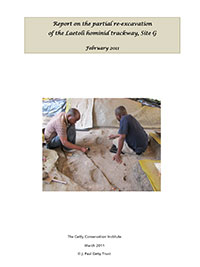
Getty Conservation Institute
2011
Download PDF Low resolution (8.1MB)
Download PDF High resolution (15.3MB)
The Pliocene site of Laetoli, which preserves both hominid and faunal tracks, has immense scientific value, particularly for understanding human evolution. The trackway at Site G, fortuitously preserved within layers of volcanic tuff, offers unique evidence of bipedalism in hominids from 3.6 million years ago. Excavated by Mary Leakey in 1978-79, the trackway was documented and then reburied underneath a mantle of soil and lava boulders. Soon after, acacia trees and other vegetation took root in the burial fill, raising concerns about the survival of the trackway. In 1993 this concern led to a joint Getty Conservation Institute–Government of Tanzania project to conserve the trackway.
The Hominid Trackway at Laetoli project ended in 1998. This report describes the evaluation of the trackway that took place in February 2011 in response to a Presidential decision (made in 2008) to open the hominid trackway at Site G permanently to public visitation.
The re-excavation of a trench over the trackway by the Department of Antiquities and the condition of the footprints uncovered is described, along with a brief assessment of the Olduvai Museum exhibition and storerooms where the casts were stored.
How to Cite this Work
Getty Conservation Institute. 2011. Report on the Partial Re-Excavation of the Laetoli Hominid Trackway, Site G. Los Angeles: Getty Conservation Institute. http://hdl.handle.net/10020/gci_pubs/laetoli_re-excavation
|
||||||||||||||||||||||||||||||||||||||||||||||